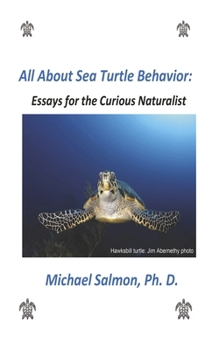All about Sea Turtle Behavior: Essays for the Curious Naturalist
This collection of essays, written for a general audience, provides a glimpse into the fascinating lives of marine turtles, certainly among the most magnificent creatures to share the planet with us. These powerful, elegant, and majestic animals can commonly be observed slowly swimming about in the world's marine seagrass meadows, coral reefs, and temperate bays and estuaries during the summer months. One species, the leatherback, possesses the ability to retain metabolic heat and so also frequents the colder, more productive waters at higher latitudes where their prey are especially abundant. These essays are meant to summarize for the curious naturalist what I think are the most important details we've learned about the current status, evolution, behavior, and (to a more limited degree) sensory capabilities of marine turtles since Archie Carr published his famous "So Excellent a Fishe" in 1967. That beautifully written description of sea turtle natural history was
filled with more questions than answers, especially with regard to how these creatures managed to survive in a hostile world and how and where they traveled as hatchlings, juveniles, and adults. We've learned a lot since then, largely thanks to technologies unavailable to Carr when he wrote his book. Even so, some of these findings are almost hard to believe To make those cases more forceful, I've purposely emphasized details almost never provided to a general audience, specifically, how current evolutionary theory prompted scientists to ask the right questions and to design the right experiments. That background helped us determine with greater certainty how marine turtles have coped with the various challenges posed by predators and other hostile forces in their environment. More than 100 million years ago, during the rise of the dinosaurs, turtles entered the sea and managed to co-exist in that environment with huge reptilian predators (the Mozasaurs, Plesiosaurs, and several ancestral crocodilians). But by 65 million years ago, those predators had disappeared while the sea turtles persisted, thrived and diversified. Since then, that diversity has been culled as natural selection eliminated the overspecialized species that were unable to cope with environmental change. Today, there are 7 species representing two marine turtle groups (the hard- and leathery-shelled forms). These are extremely successful animals that until recently, existed in abundance. Unfortunately, humans have become their most serious and effective enemy. We, and not natural selection, are entirely responsible for their status today as threatened or endangered species.
filled with more questions than answers, especially with regard to how these creatures managed to survive in a hostile world and how and where they traveled as hatchlings, juveniles, and adults. We've learned a lot since then, largely thanks to technologies unavailable to Carr when he wrote his book. Even so, some of these findings are almost hard to believe To make those cases more forceful, I've purposely emphasized details almost never provided to a general audience, specifically, how current evolutionary theory prompted scientists to ask the right questions and to design the right experiments. That background helped us determine with greater certainty how marine turtles have coped with the various challenges posed by predators and other hostile forces in their environment. More than 100 million years ago, during the rise of the dinosaurs, turtles entered the sea and managed to co-exist in that environment with huge reptilian predators (the Mozasaurs, Plesiosaurs, and several ancestral crocodilians). But by 65 million years ago, those predators had disappeared while the sea turtles persisted, thrived and diversified. Since then, that diversity has been culled as natural selection eliminated the overspecialized species that were unable to cope with environmental change. Today, there are 7 species representing two marine turtle groups (the hard- and leathery-shelled forms). These are extremely successful animals that until recently, existed in abundance. Unfortunately, humans have become their most serious and effective enemy. We, and not natural selection, are entirely responsible for their status today as threatened or endangered species.
Format:Paperback
Language:English
ISBN:B0FLT97L48
ISBN13:9798317812652
Release Date:October 2025
Publisher:Bookbaby
Length:160 Pages
Customer Reviews
0 rating





